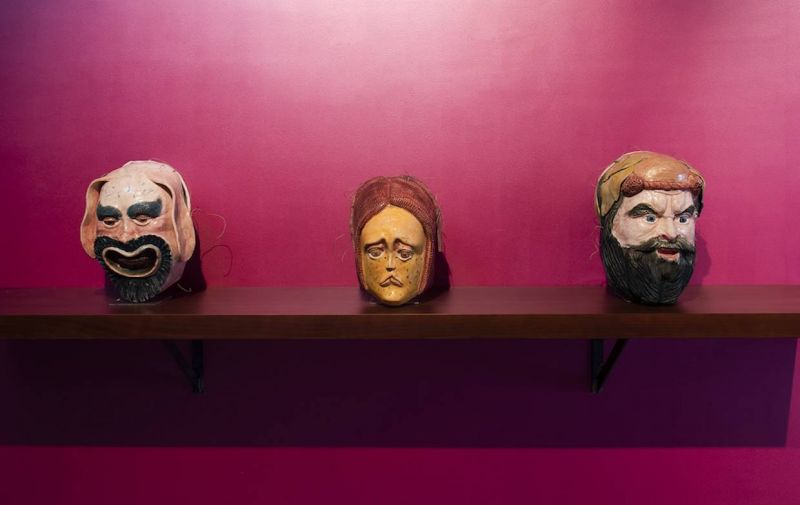
Wael Shawky. Ceramic masks, 2022, glazed ceramic, oil paint. (Courtesy of Sfeir-Semler Gallery)
BEIRUT — The left corner of the reception hall is piled with sand, as if years of wind had blown it there. Emerging from the center of the mound is a single white amphora — those ceramic jugs the Greeks and Romans used to ship goods around the Mediterranean. The cargo of this shipment was peculiar. Protruding from the amphora, it seems, are numerous human feet — some minuscule in their stylized shoes, others bare, toes splayed.
“This is a link between Egyptian mythology, which the Romans basically hijacked when they occupied Egypt,” Wael Shawky nods at his work, explaining that the jug portion of the piece recalls a series of Roman and Greek-inspired amphorae of his, shown in Milan recently. “For me, it also reflects an idea of the Egyptian desert, which is connected to this mythology we are creating.”
The installation is the prelude to “I Am Hymns of the New Temples,” the Egyptian artist’s latest show at Sfeir-Semler's Karantina space. Shawky works in a wide range of media, from pen-and-ink sketches to objects (installation and sculpture in various media), musical performance and moving image (short non-fiction video works and more elaborate historical fictions using marionettes, shot on 35mm film).
This exhibition hinges on the artist’s latest film, the hourlong work that gives the show its name. In one way or another, all the other pieces — foyer installation, canvases, series of bronzes and ceramic masks — reflect and reiterate the motifs of the film and Shawky’s practice generally.
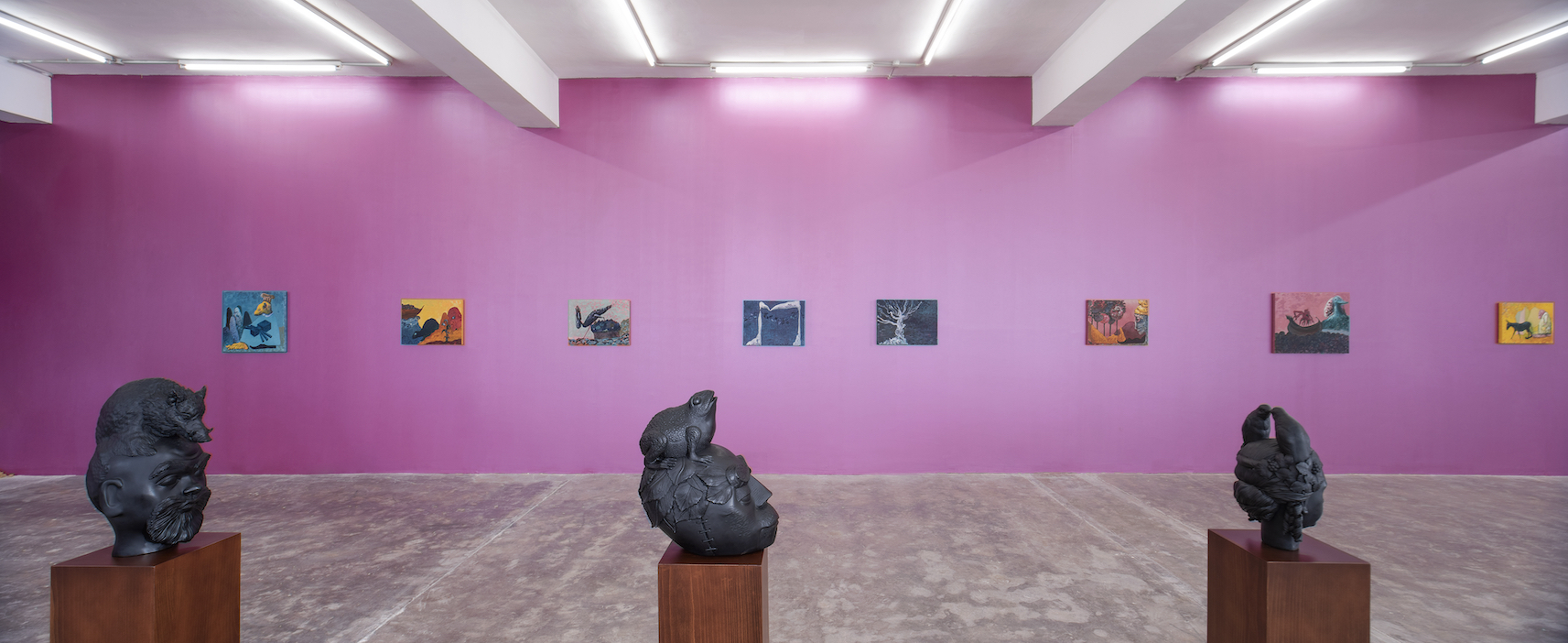 Shawky. Exhibition view. Busts, (Birds head, Frog head, Pig head), 2023, bronze. (Courtesy of Sfeir-Semler Gallery)
Shawky. Exhibition view. Busts, (Birds head, Frog head, Pig head), 2023, bronze. (Courtesy of Sfeir-Semler Gallery)
Shawky summarized how he sees his work during an interview on his “Cabaret Crusades: Secrets of Karbala,” exhibited at Sfeir-Semler in 2015.
“Art, for me, is about translation and transformation,” he said. “We transform one form into another. I translate this type of creation — written history, text — into a new form.”
“I Am Hymns of the New Temples” is a departure for Shawky, insofar as the film’s subject matter is the mythology of classical Greece and Rome. His past work has been rooted in the Arab world, taking up themes from Arabic literature, stories from the Quran and the Crusades — the subject of this film trilogy “Cabaret Crusades,” (2010-14).
“Hymns” is also new in that, unlike Shawky’s historical fictions, it was not made with a gallery exhibition in mind.
“I think the difference between [“Hymns”] and the other films is that you need time to watch this one because of its narrative,” Shawky tells L’Orient Today. “With ‘Cabaret Crusades,’ for example, you can enter halfway through the film, watch five or 10 minutes and leave. It’s okay, because history doesn’t have a beginning and end. Here the story is very different.”
Of myths and movies
“Hymns” recounts act one of humans’ story — from the void, through the creation of several generations of gods, to humans, to a miffed deity’s decision to drown the lot in a cataclysmic flood.
Shawky pitched the film to the Italian government in 2020 as a project for the Pompeii Archaeological Park. Andrea Viliani curated the production in collaboration with Pompeii Commitment. Archaeological Matters — the entity overseeing the production of contemporary art and cultural projects for the park. It premiered at the Pompeii archaeological site earlier this year.
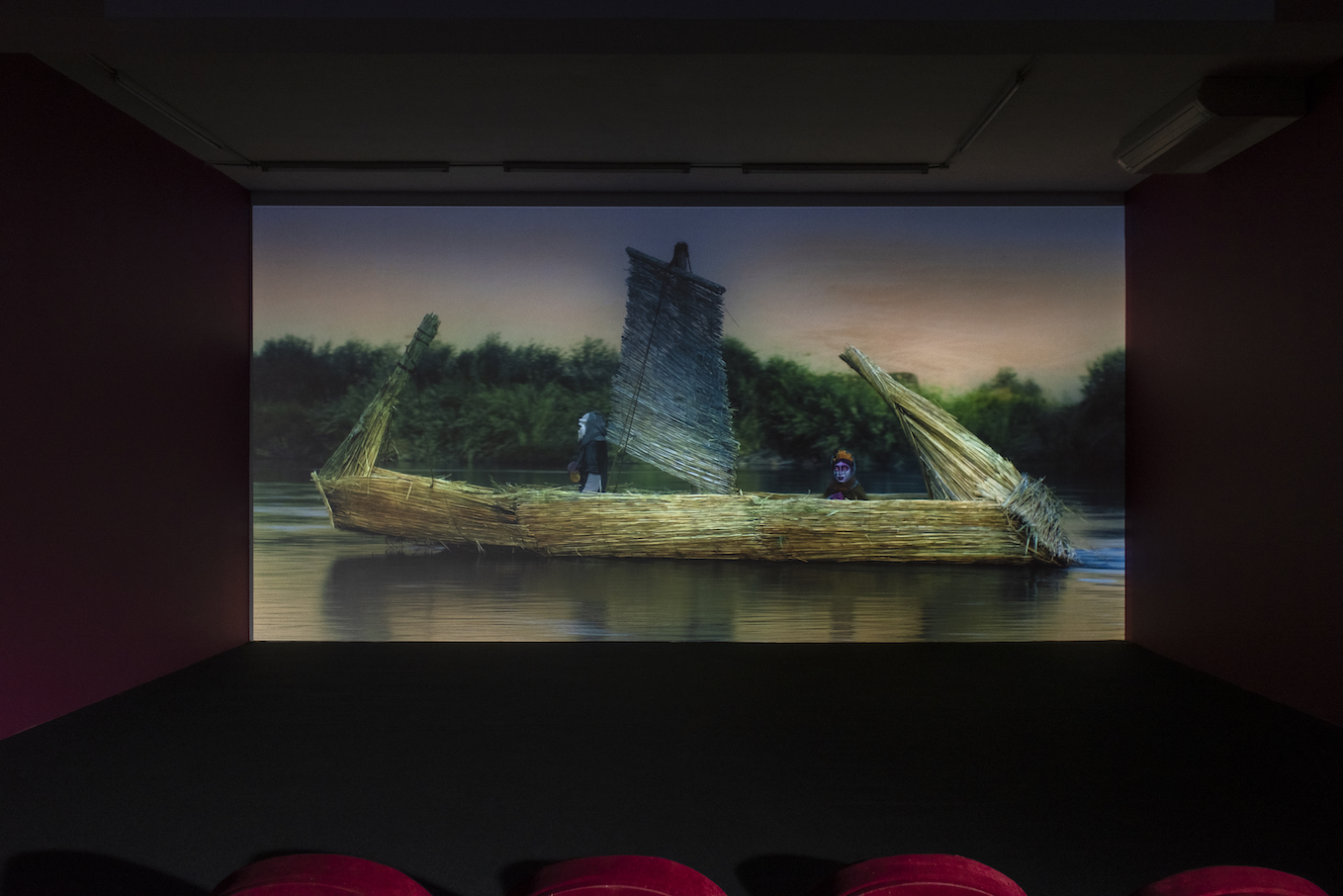 Shawky. "I Am Hymns of the New Temples," 2023, single channel video, color, sound, 57’43”. (Courtesy of Sfeir-Semler Gallery)
Shawky. "I Am Hymns of the New Temples," 2023, single channel video, color, sound, 57’43”. (Courtesy of Sfeir-Semler Gallery)
Pompeii was a Roman town before Vesuvius buried it in ash, so it’s not surprising that the gods, goddesses and humans in Shawky’s film are those of Greco-Roman mythology and that, in broad strokes, the events depicted are familiar to anyone whose school curriculum or television entertainment have alighted upon the bronze- and iron-age eastern Mediterranean.
The story, as Shawky notes, is far more universal than Greece and Rome — with early civilizations in South Asia and the Americas, ancient Iraq, Palestine and beyond having recounted similar tales of creation, human insolence and extinction.
“It’s everybody’s story,” the artist says, “exactly the same story that you find in all religions … If you look, you always find that [an episode or character] is reflected in other stories. I think this is really interesting.”
Shawky is less interested in the beginning and the end — the void and the drowning — than in the middle bits, when the lecherous Zeus overthrew his father Cronus to become chief deity and humans appeared on the scene. One version of the story suggests the species was created by Prometheus, the deity best known for giving humans the secret of fire, thus technology and civilization. In retribution, Zeus punishes Prometheus and offers the species a gift of his own — Pandora, the first mortal woman.
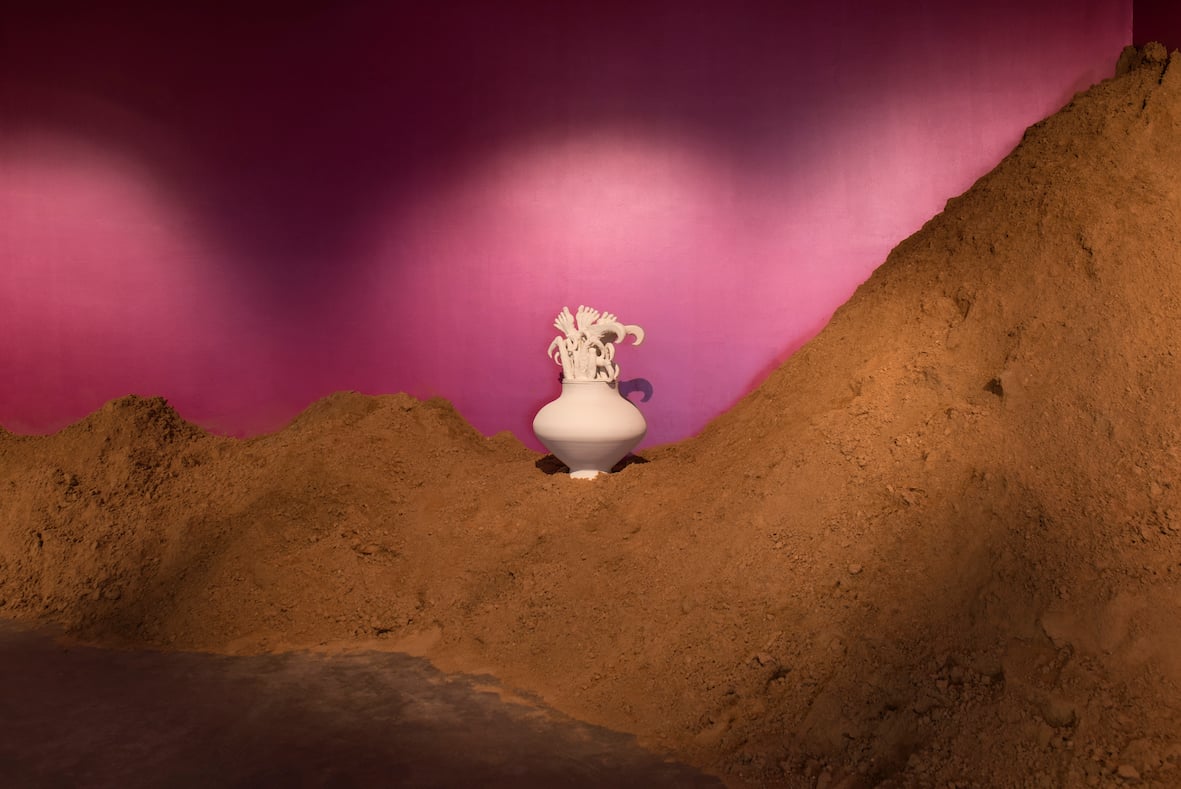 Shawky. "Untitled," 2023, ceramic amphora with lid. (Courtesy of Sfeir-Semler Gallery)
Shawky. "Untitled," 2023, ceramic amphora with lid. (Courtesy of Sfeir-Semler Gallery)
As the story goes, the Olympian gods explicitly designed Pandora to tempt the (previously men-only) species into mischief. She also carried with her a jar (not a box) of assorted evils that have afflicted the species ever since.
“There are many other stories relating to how woman [Pandora or woman by any other name] embodied temptation,” Shawky muses. “Zeus created women to punish mankind, but Zeus himself fell in love with a human woman, named Io.”
At the heart of Io’s story is one of those mythic reflections that interest Shawky.
Predictably, Zeus came to lust for Io. His wife Hera, ever vigilant of her husband’s philandering, sought to punish the woman. To protect her, Zeus transformed Io into a cow. Undeceived, Hera dispatched a horsefly to torture the heifer, and the changeling spent years wandering the globe trying to escape the pest.
Io eventually arrived in Egypt, where she regained human form. Zeus promptly had sex with her and the child born of this union was called Osiris. In Pharaonic Egypt’s mythology, Osiris was a significant deity with his own story, being the god of fertility, agriculture, the afterlife, the dead, resurrection, life and vegetation. Somewhere along the line of transmission, humans came to associate the Greek Io with the Egyptian goddess Isis.
“This is an Egyptian myth adapted [for Greco-Roman consumption],” Shawky says. “In Egyptian mythology, Osiris’ lover is his sister Isis. In the Greek adaptation, Io (Isis) is the lover of Zeus, while Osiris becomes their offspring. Basically, this version of the story places Greco-Roman mythology above Egyptian mythology.
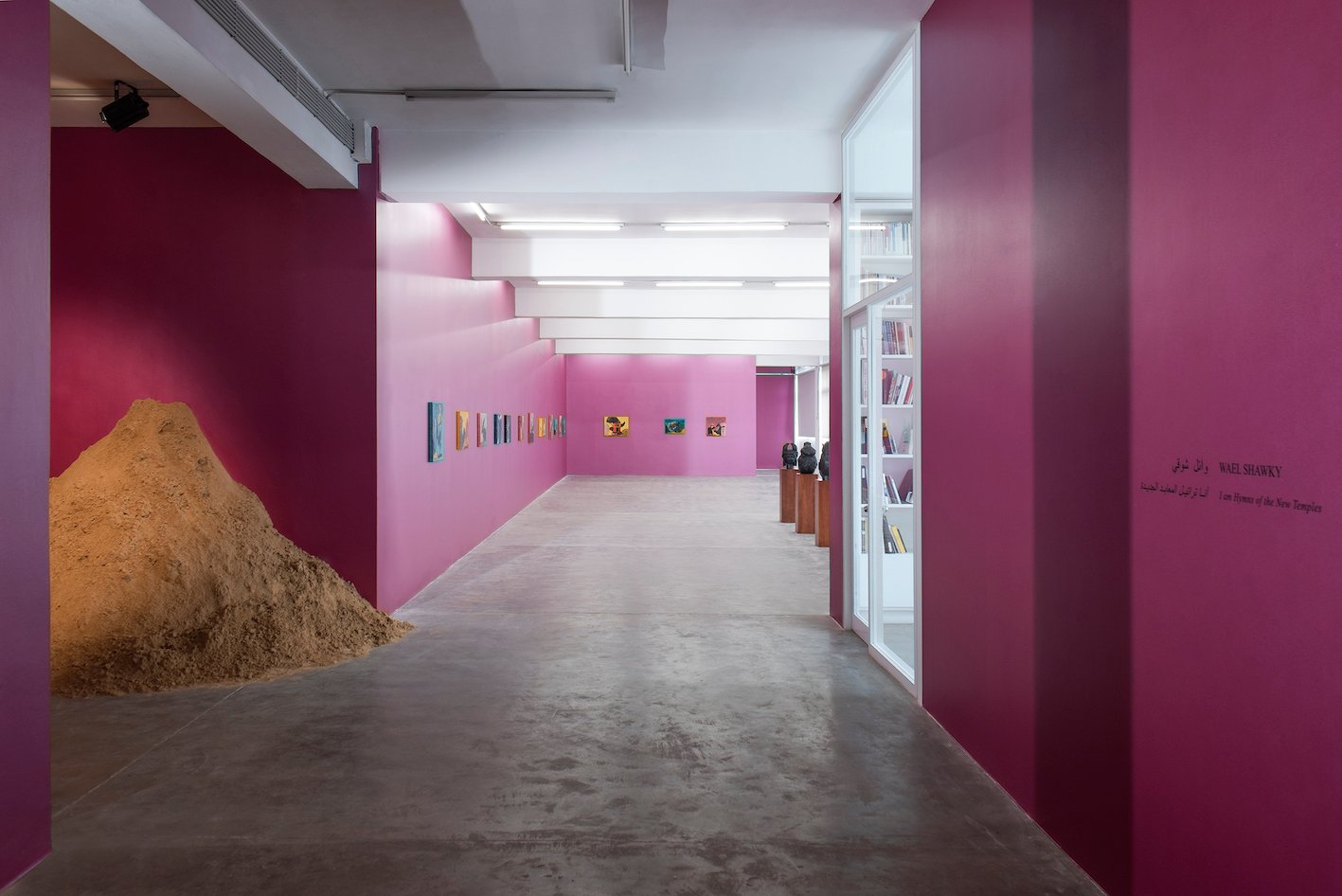 Shawky. "I Am Hymns of the New Temples", 2023, exhibition view. (Courtesy of Sfeir-Semler Gallery)
Shawky. "I Am Hymns of the New Temples", 2023, exhibition view. (Courtesy of Sfeir-Semler Gallery)
“It doesn’t matter. It’s all myth,” he smiles. “In the end, it’s about human creation, about the beauty of how human beings created this story.”
Forms and hybridity
The narrative of “Hymns” marks a departure for Shawky but in its formal conceits the work in this exhibition conforms to the artist’s past practice — whether it be the use of classical Arabic to tell European or proto-European stories (as in “Cabaret Crusades”), or the tunes the artist composes for them to sing (as in his Arabic version of “The Song of Roland”). The most prominent visual element is the “transformational” figuration that first emerged in his pen-and-ink sketches.
In “Secrets of Karbala” Shawky explored this hybridity in the otherworldly aspect of some of the glass marionettes he designed to portray that film’s historical characters. “Hymns” takes its cue from the hybridity the artist finds within the mythology itself. Mortal and immortal characters are played by human performers who may resemble homo sapiens — if their stylized masks adhere to those worn by stage actors in ancient Greece and Rome — but not always.
“It’s like a translation of a certain moment in mythology, maybe, when human beings were incomplete,” Shawky suggests. “This is before they became human beings … What you see is not a human being and it’s not a marionette. It's something in-between, still trying to become whole.”
The hybridized forms and vistas captured in the show’s oil paintings emulate the characters and locations in the film, but they are also colorful renderings of themes in the artist’s earlier monochrome drawings.
In one canvas, a slouching, amiable-looking fellow with a doric column projecting from his potato-shaped head extends one unshod foot, which might be human but for its anemone of toes. Elsewhere, a six-legged, two-armed fellow appears to be pushing a stalled car across a landscape. Unlike the figure himself, his vehicle has eyes, ears and a thick shock of black hair.
The same is true of the sculptures in this exhibition. Like the marionettes Shawky fashioned for “Cabaret Crusades,” the facial features captured in the busts echo those of the ceramic masks in the film. Each of them seems to balance something on its head, hat-like — a frog, a pair of songbirds, a diminutive boar.
Shawky appreciates how his mythic source material resonates with contemporary human realities — and not only the apocalypse of global sea level rise.
“What’s also nice about this story,” he says, “is that the idea of justice was embedded in humanity before any type of religion … Human beings support dictators, injustice and the powerful over poor people, goodness or justice … [but] whatever happens today will have a consequence, even if it takes 1,000 years.”
Wael Shawky’s “I Am Hymns of the New Temples” is up at Sfeir-Semler’s Karantina space through Dec. 29, 2023.
